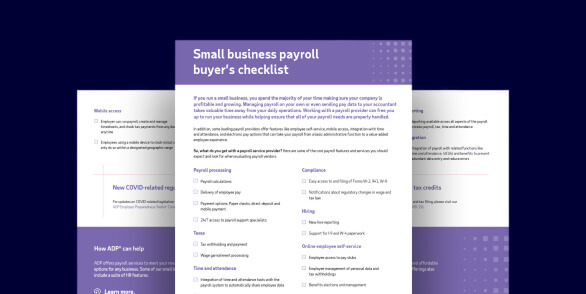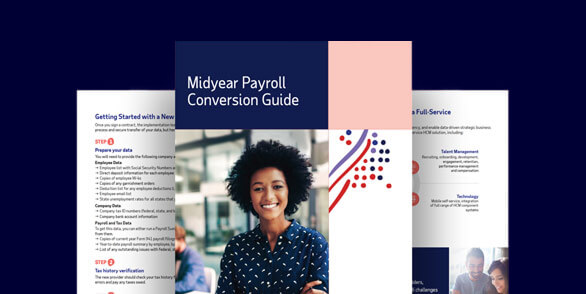insight
How much does it cost to run payroll?
What can you do to save money on payroll services costs?
Payroll is one of the many costs of doing business for those that have employees. This expense typically varies depending on the payroll method, the size of your business and where it operates. Accuracy is also important because government agencies may impose costly fines on employers who make mistakes or miss deadlines.
Table of Contents
How much do payroll services cost?
Different payroll providers offer different pricing structures, but most have per-payroll processing or per-employee fees. There may also be annual or monthly base costs for additional services, like year-end Form W-2 preparation and delivery.
Common factors that affect payroll cost
Payroll is not a one size fits all service. Various aspects will determine total cost, such as:
- Payroll frequency
- Total number of employees
- The types of services needed
- How often payees are added or removed
- The number of states where people are employed
Additional payroll service fees
A payroll provider’s price structure may not always include everything you need to run payroll from start to finish. Services that sometimes incur separate fees include:
- Direct deposit
- Automatic check signing
- Paycheck printing and delivery
- Tax filing
- Year-end processing (Forms W-2, 1099, etc.)
Add-ons can drastically increase payroll expenses, so employers may want to confirm what services are included in the package before making a commitment with a provider.
New hire reporting
The federal government requires employers to report new or rehired employees to a designated state agency within 20 days. Some payroll providers will file these reports on behalf of a client at no added cost, but others may consider this an add-on service.
Explore Learn all about ADP's small business payroll solutions
Cost of payroll services for small businesses
Small businesses today have realistic, affordable ways to deliver a world-class payroll outcome. Their options are to do it themselves, purchase payroll software or outsource payroll to a full-service provider. Whichever of these methods is chosen, along with the size of the workforce and the specific services needed, will largely determine the total cost.
Do-it-yourself payroll
DIY is the cheapest payroll option and one that some businesses choose in their early stages. With this approach, expenses typically depend on how employees are paid. Banks, for instance, charge fees for direct deposit and checks come with the cost of paper, printing and delivery.
There is one caveat, however, for small business owners who calculate payroll on their own. It’s time-consuming and errors are expensive, especially if it becomes necessary to hire a tax attorney.

Get long-term savings when you run payroll with ADP
Partner with a provider that actually helps you save money.
Payroll outsourcing costs
Comprehensive or managed payroll costs more than DIY payroll, but it could actually save money in the long-term because it limits the risk of tax penalties. The total expense usually hinges on the individual provider’s price per employee or processing, as well as any payroll outsourcing base fees they may charge.
Partnering with an HR and payroll provider
In addition to cost, employers should consider the value of the time they’ll get back by partnering with an HR and payroll provider. Alleviating administrative burdens usually allows them to focus on growing their business and improving their profit margins. For this reason, employers may want to automate or outsource payroll as soon as they have the budget to do so.
Explore Want to learn more about outsourcing your payroll?
Frequently asked questions about payroll cost
How much is ADP payroll?
ADP offers solutions for all types of payroll from the simple to the complex. We’ll work with employers to determine the individual setup that’s right for their business and fits their budget.
How much does it cost to use a payroll company?
No two payroll companies are the same. That’s why when weighing costs, it’s essential for employers to consider the overall value they’ll receive from the provider. Pay particular attention to customer support and how well the software integrates with other products.
How much does it cost to have someone do your payroll?
Having someone, such as an accountant, process payroll can be expensive because the calculations are time-consuming and many CPAs charge by the hour. Hiring a professional on staff may not be any cheaper either. Employers will have to pay a salary, benefits and the related payroll taxes on that person’s income.
How do you calculate payroll costs?
To calculate payroll costs, employers generally need to total these expenses:
- Payroll service provider fees
- Employee wages
- Employer payroll taxes
- Unemployment insurance
- Worker’s compensation insurance
- Paycheck printing and delivery
- Direct deposit
Note that not all of these costs may apply, depending on how payroll is processed.
How much does online payroll cost?
Online payroll services usually charge by the number of employees per payroll processing. Add-on services can be purchased as necessary for a monthly or annual base fee.
What does ADP payroll cost per employee?
ADP provides payroll services priced for businesses of any size. So whether an employer has just one worker at a single location or thousands of employees operating around the globe, we have a payroll solution for them.
Ready to get help with your payroll?
Make payroll fast and easy with automatic tax calculations, deductions and filing done for you. We’ll even help you avoid costly mistakes before they happen.
Want more exclusive business insights like this delivered to your inbox?Subscribe now
This guide is intended to be used as a starting point in analyzing how to do a payroll and is not a comprehensive resource of requirements. It offers practical information concerning the subject matter and is provided with the understanding that ADP is not rendering legal or tax guidance or other professional services. Please consult with your legal counsel.
1. ZipRecruiter is a registered trademark of ZipRecruiter, Inc.
2. Legal services are provided by Upnetic Legal Services, a third-party provider




